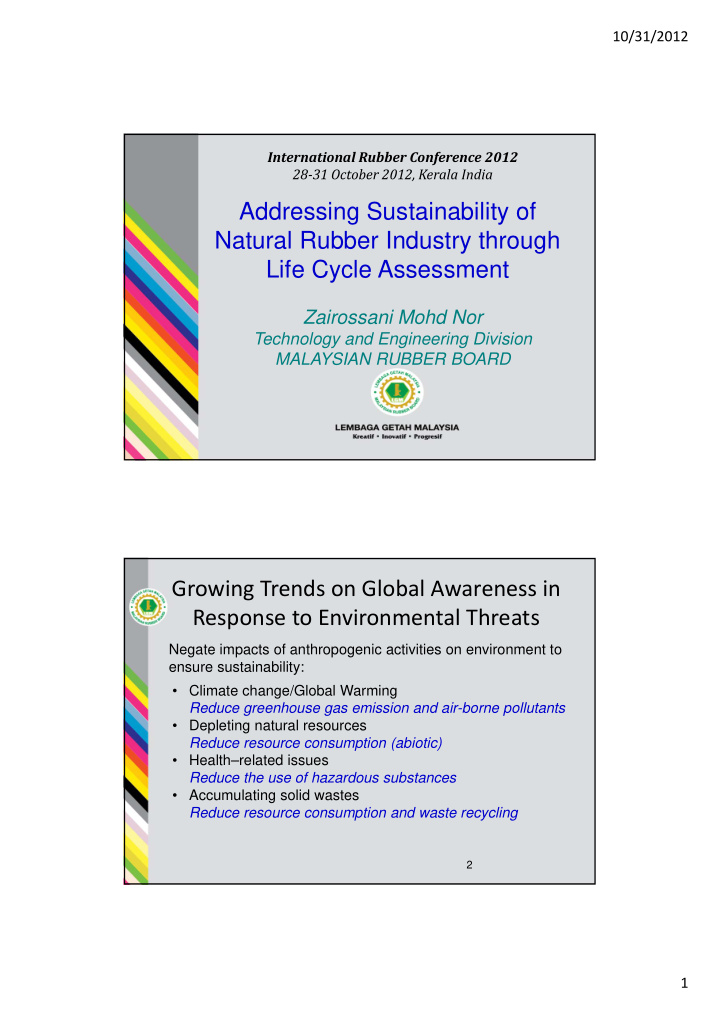



10/31/2012 International Rubber Conference 2012 28 31 October 2012, Kerala India Addressing Sustainability of Natural Rubber Industry through Life Cycle Assessment Zairossani Mohd Nor Technology and Engineering Division MALAYSIAN RUBBER BOARD Growing Trends on Global Awareness in Response to Environmental Threats Negate impacts of anthropogenic activities on environment to ensure sustainability: • Climate change/Global Warming Reduce greenhouse gas emission and air-borne pollutants • Depleting natural resources Reduce resource consumption (abiotic) • Health–related issues Reduce the use of hazardous substances • Accumulating solid wastes Reduce resource consumption and waste recycling 2 1
10/31/2012 Drivers of Environmental Awareness Europe - EU policies such as IPP, REACH, EuP, RoHS - Directives for Promotion of Renewable Energy - Green Public Procurement - Tyre Performance Labeling Japan + Law for a Sound Material-Cycle Society + Green Procurement Policy in government sector + Product Green Promotion Program + Eco-Labeling Program USA * USEPA Product Stewardship Program Clean Development Mechanism (CDM) – Certified Emission Reduction (Kyoto Protocol) (2008-2012) Conceptual Approach The Dominant Model Dependency of economic, social and environmental aspects (sustainability pillars) Social (People) Sustainable Development Environment Economy (Planet) (Profit) Sustainability is not only about environmental sustainability but to achieve a balance, interdependent and mutually reinforcing economic, social and environmental aspects 2
10/31/2012 Conceptual Approach Sustainable development is a process of progress in which: • exploitations of resources • strategy for investments • technological development and innovations • institutional changes are made consistent with both present and future requirements. Sustainable development is not only about environment but about efficient use of resources Sustainable Rubber Industry? Upstream Midstream Downstream (Plantation) (Processing) (manufacturing) Status at an initial stage of implementation: • Optimization of resources Renewable natural rubber, energy reduction, non-toxic chemicals or raw materials • Environmental Impacts Waste minimization and utilization, recycling and environment management systems (ISO-14000 series standards) • Technological development R&D in cost-competitive and eco-efficient technologies (green rubbers, green rubber products) • Institutional changes Comprehensive environmental regulations 3
10/31/2012 Life Cycle Assessment • LCA is an environmental management method for the quantitative evaluation of material resources invested, the environmental burden and the environmental impact on the earth of a product or service through all stages of its life cycle (Narita, 2004) • LCA is an indicator for sustainability • LCA assess the environmental aspects and potential impact of a product through; – Compiling an inventory data concerning inputs and outputs of a product system – Evaluating the potential environmental impact associated with those inputs and outputs – Interpreting the results of the inventory analysis and impact assessment phases in relation to the objectives of the study 7 Life Cycle Impact Assessment (LCIA) Inventory Impact LCIA (e.g. emission/kg) Category Global warming CFP CO 2 • CH 4 • Ozone layer depletion Emissions Emissions CFCs • to air to air Raw Material SO x • Acidification Acquisition NO x • Better Photo Oxidation NH 3 • Products? Production HCl • Eutrophication VOC • Use PO 4 3 ‐ • Human toxicity Emissions Emissions NO 3 • Disposal to water to water COD • 4
10/31/2012 Examples of Life Cycle Assessment (LCA) & Carbon Footprint (CFP) in Practice Type I Type III LCA & CFP for Standard Malaysian Rubber (SMR) Production 5
10/31/2012 System Boundary of LCA for SMR Production ‘Cradle to Grave’ Approach (‘Tree to SMR’ Approach) Immature & Immature & SMR Matured Nursery Production Rubber Trees Rubber Trees ‘Cradle to Gate’ Approach Rubber Rubber Product Product Usage Manufacturing & Disposal Scope of LCA Study • Functional unit in this study will be the production of 1000 kg of SMR 10/20 • All calculations of masses and emissions in this study are based on the defined functional unit • All environmental Impact categories (especially CFP) in this study are based on the defined functional unit 6
10/31/2012 System Boundary of LCA for SMR Production 2-Whorl Planting Rubber Material Seeds Nursery Matured Tree Plantation (6 years) (Immature) Field CO 2 Emission CO 2 Sequestration Coagulum Plantation (50% DRC) (Matured) CO 2 Sequestration SMR Production CO 2 Sequestration Input-Output Table for SMR Production (Cradle to Gate) FU: 1000 kg of SMR 10/20 Input Quantity Unit Output Quantity Unit Cuplump (50% drc) and 2000 kg SMR 10/20 1000 Kg its upstream processes* Water (untreated) 19860 L Methane (CH 4) 3.43 Kg Diesel 36 Kg COD 1.61 Kg Electricity 190 kwh Suspended 0.53 Kg solids Transport 100 Ton.km Total Nitrogen 0.51 Kg * Two-whorl and immatured/matured rubber tree production 7
10/31/2012 TREE ANALYSIS (SimaPro) Input-Output Table for SMR Processing (Gate to Gate) FU: 1000 kg of SMR 10/20 Input Quantity Unit Output Quantity Unit Water (untreated) 19860 L SMR 10/20 1000 Kg Diesel 36 Kg CH 4 3.43 Kg Electricity 190 kwh COD 1.611 Kg Transport 100 Tan.km Suspended solid 0.529 Kg Total Nitrogen 0.507 Kg COD – Chemical Oxygen Demand of Final Effluent 8
10/31/2012 TREE ANALYSIS (SimaPro) Impact Assessment – Characterization based on FU of 1000kg SMR 10/20 9
10/31/2012 Impact Assessment – Normalization based on FU of 1000kg SMR 10/20 Impact Assessment – Interpretation (Screening CFP) Life Cycle Stage Carbon Footprint (CFP) SMR Production 1.10 kg CO 2 /kg SMR (Cradle to Gate) CO 2 sequestration -6.12 kg CO 2 /kg SMR ‘Cradle to Gate’ (5.02 kg CO 2 /kg SMR of net sequestration) 10
10/31/2012 TREE ANALYSIS (SimaPro) Environmental Impact Avoidance by Switching from Diesel to Biomass in SMR Production Thank You 11
Recommend
More recommend